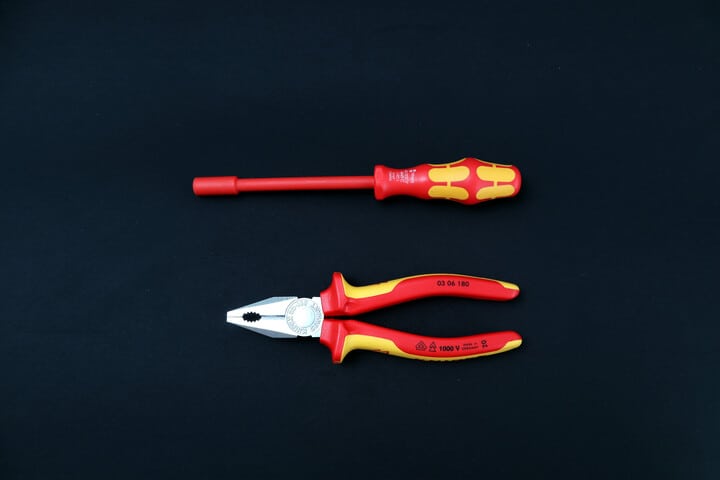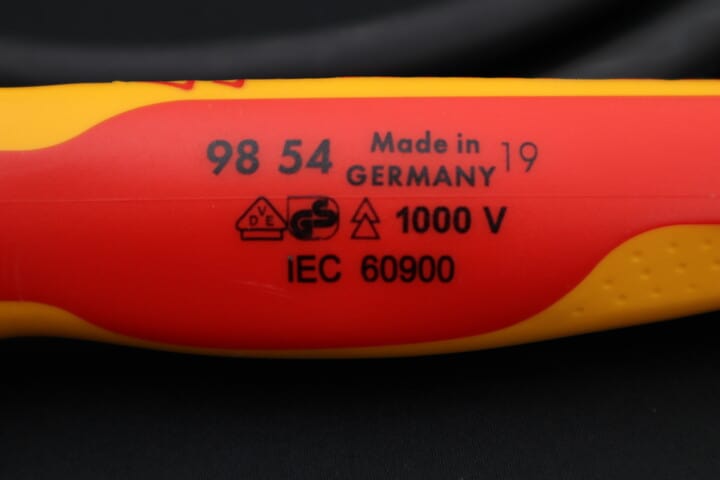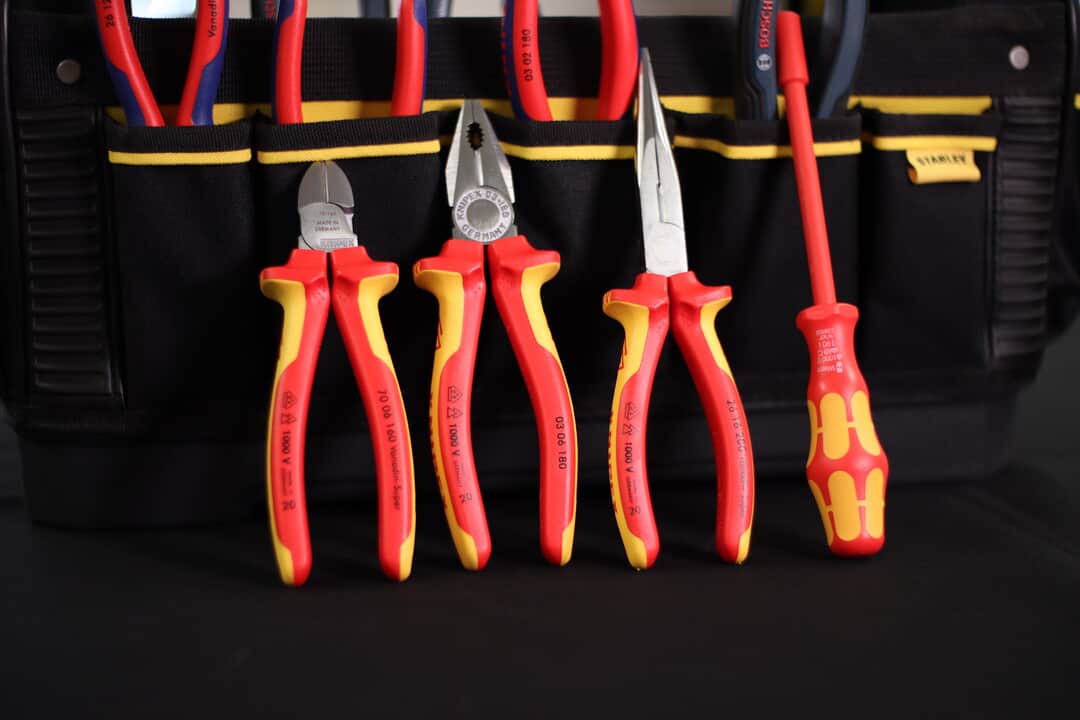If you have been working in electronics or electrical installation and maintenance for any length of time, you probably have run into the topic of insulated tools. These tools claim to offer improvements in safety, and are considered essential by some for any work near electricity.
You may have wondered when exactly are insulated tools required, and should you also be using them? In this article, we are going to answer these questions, and help you tell if you need to add some of the brightly colored 1000V tools to your arsenal.
The answer, in short, is that the use of insulated tools is recommended whenever working with or near equipment which may contain potentials higher than 50 V, such as devices that are, may be, or may have recently been connected to line power. Further, the use of insulated tools is often required by insurance companies and professional organizations.
Next, we are going to explain insulated tools in more detail, and answer the most common questions on the subject. If you are interested in finding out more, this article should be helpful to you.
What are insulated tools?
Insulated tools are special versions of some hand tools, which offer additional protection against electric shock by improved insulation.
The added protection comes most often in the form of
- thicker dielectric layers (i.e. rubber or plastic) on the tool handle
- extension of these layers further from the handle, and
- features which prevent the user’s hand from slipping from the handle towards uninsulated areas
The most common tools to be offered in insulated versions are different types of pliers and screwdrivers, which are essential in electrical installation and maintenance work. Some wrenches and cable knives are also available in insulated versions.

Insulated tools are most commonly rated for work with voltage levels up to 1000 V AC and 1500 V DC, and may sometimes be simply called “1000-Volt tools” or also “VDE tools” after the German certification agency Verband der Elektrotechnik responsible for a large portion of the standards testing.
When should I use insulated tools?
You should use insulated tools whenever you are working on or near equipment which may contain potentials higher than 50 Volts. These are the scope of work and the voltage level set by the standard NFPA 70E for all professional work in the US, and recommended also for non-professionals.
You should note that this clause is actually very wide:
- In practice, this means all equipment which are connected to line voltages, typically 110 V or 230/240 V
- However, it further includes all equipment which may no longer be, but have recently been connected to lline voltages. The reason for this inclusion is that such devices may still contain hazardous voltages in the high-side storage capacitors, for example, although the power lead has been disconnected.
- It is good to remember that not only line-connected, but also some low-voltage systems running at 60 V or 70 V call for insulated tools.
If you are a professional electrician, you should also note that you may be required to use insulated tools by your professional community, your employer, or your insurance company.
How do you tell if a tool is insulated?
You can get a hint if a tool is insulated by looking at its handle: most 1000 Volt rated insulated tools have handles that are either red, yellow, orange, or a combination of these colors. The red&yellow high-visibility combination used by German brands Wiha, Knipex and Wera, as well as Fluke and some others in the US, is particularly recognizable.
To tell if a tool is insulated with certainty, you will have to look for certification symbols on the tool. These will include:
- a double triangle symbol
- the voltage rating (commonly 1000 V), and
- the standard number(s) after which the tool has been certified, and possibly the symbols of the certifying organization. The most common standards are IEC 60900:2004 and ASTM F1505.

How much do insulated tools cost?
Insulated tools are slightly more expensive than the corresponding non-insulated or unrated tools.
The price difference between insulated tools and their regular counterparts is usually around $10 with premium brands. If a pair of non-rated regular diagonal cutters from a quality brand cost $25, the insulated versions are usually around $35.
You may also have to factor in an another cost riser: officially rated insulated tools are often available only from premium manufacturers. This means that the low-cost options you might otherwise rely on are not available if you need an insulated tool, and you will be paying a bit more both for the insulation and the brand.
Are there any disadvantages to insulated tools?
Apart from the higher price, the disadvantages of insulated tools are minor.
One drawback for some users are the thicker handles. Depending on how you are used to holding the tools, the thicker insulating layer may make some of your grips slightly less comfortable. It will also take up more space in storage, so that your pliers and screwdrivers will not lay quite as flat as the regular versions.
An another potential disadvantage specific to screwdrivers is the insulated shaft on the tool. The insulation makes the shaft thicker, and can make fitting it to tight holes more difficult.
Can you replace insulated tools with gloves?
“Why buy a whole set of expensive insulated tools when a single pair of rubber gloves will do the trick?”
This question, presented on online electronics forums, is a valid one. However, although wearing insulating Electrician’s gloves does indeed provide you with some added protection,the protection offered by gloves is usually not enough to replace insulated tools.
To understand why, consider the thickness of the plastics or rubber layer on the handles of insulated tools. For a tool to be rated 1000-Volt compliant, it actually has to withstand a much higher voltage (usually 10,000 Volts) to have a sufficient safety factor regarding the insulation. To prevent dielectric breakdown and arc flash with certainty, the insulating layer has to be this thick.
Rubber gloves, even the Electrician’s gloves, are in reality much thinner than the insulating layers on insulated tools, and have a lower protection level. If they had the same protection level, they would so thick that you could not move your fingers. Even as they stand, gloves with a some level of added protection are thick and will limit your dexterity.
Can you insulate you tools yourself?
An another proposed alternative to officially rated insulated tools, often suggested on online forums, is insulating your regular tools yourself. While this is certainly possible with enough planning and care in execution, self-insulated tools often fall well below the officially rated ones in the level of protection provided, and I would not recommend as substitutes.
The first challenge with self-insulated tools is that you would actually have to do some high-voltage electrical engineering design to plan the insulation. You will have to detect the possible conduction paths, select the insulation materials and check the insulation resistance and breakdown voltages. In reality, this may take much more effort than you think.
The second challenge is that you would have to follow up your plan with a very careful execution to actually realize the planned insulation reliably. As an example, electrical tape often employed in self-insulating work is too thin on its own to meet the official ratings, and does not reliably stay in place over years of use in varying conditions.
Properly insulating your tools yourself actually takes so much work that you will usually be much better off spending the additional $10 to get the insulated versions.
Do I need insulated tools if I disconnect equipment?
“But I unplug the device from the line before starting work”
is an excuse often presented for not using insulated tools when working on electrical equipment.
The excuse has a great deal of sense to it: unplugging a device prevents the line from continuously energizing it to hazardous potentials, and yes, whenever possible, you should indeed disconnect a device from the line voltage before starting working on it.
Nevertheless, you should still use insulated tools. The reason for this is that many components inside the device may actually contain hazardous potentials for a period time after being disconnected from line voltages.
A case in point are the line-voltage capacitors in the power supply units of many line-powered devices. In properly functioning units, these capacitors should automatically discharge themselves through an internal path in a few seconds after disconnecting. In poorly designed or compromised units, however, these capacitors may hold hazardous voltages for a long period after unplugging.
Are insulated tools worth it?
If you work with electrical line-powered equipment, then insulated tools are worth it.
If you are a professional electrician, try to estimate how much time and money you or your employer spends on safety training and work-related insurance. I bet this sum of money is many times the added cost of a set of insulated tools vs. regular ones.
Next, think how effective the insulated tools are in actually preventing accidents. This short consideration should convince you that insulated tools are a very cost-efficient means of increasing occupational safety.
Conclusion
What we have learned can be summed up in one sentence: you should probably be using insulated tools in almost all electrical work on line-powered equipment, both officially and from a safety point of view. This is more often than you would think.
You should probably be using insulated tools in almost all work on line-powered equipment.
So if you are getting a tool set for general-purpose work and you suspect that even some work on line equipment may be coming up, it makes sense to carry the small additional cost and get the insulated versions.
